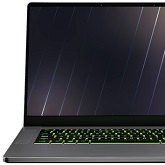NVIDIA GeForce RTX 3080, RTX 3070 and RTX 3060 – specifications and technical aspects of the new Ampere cards for laptops
Source: Pure PC added 12th Jan 2021NVIDIA today unveiled a new generation of notebook graphics cards. GeForce RTX cards 3060, GeForce RTX 3070 and GeForce RTX 3080. In the first place, however, there are two more powerful systems in stores, based on the Ampere GA core 104. For GeForce RTX 3060, the laptops will be available in late February at from 999 dollars. The technical aspects were not particularly focused on the presentation. Fortunately, a bit more information appeared after the presentation. We get quite an interesting case in the context of GeForce RTX 3060 – the mobile version offers more CUDA, Tensor and RT cores, but at the same time twice less memory, with lower bandwidth. What is the situation with the other cards and what functionalities can we count on in the upcoming laptops?
We got to know the details of the specifications of NVIDIA GeForce RTX graphics cards 3060, RTX 3070 and RTX 3080 in versions intended for laptops. I must admit that the most interesting is the lowest Ampere chip, based on the GA core 106.
NVIDIA GeForce RTX 3080, RTX 3070 and RTX 3060 – presentation of the new Ampere generation of graphics cards for gaming laptops
NVIDIA GeForce RTX 3060 is based generally on the Ampere GA core 106 with size 300 mm², equipped with m .in. in 13, 2 billion transistors. The full chip has CUDA cores 4096. Thus, neither the mobile nor the desktop card has a full GA core 104. In the case of a desktop card, 28 SM blocks from 3584 stream processors. The mobile version of RTX 3060 comes with 30 SM blocks and 3840 CUDA cores. Full GA 106 has 31658 Streaming Multiprocessors blocks. NVIDIA has also gone crazy about VRAM. Desktop card comes with 12 GB GDDR6 effective clock speed 17000 MHz. The mobile version has 6 GB VRAM clocked 14000 MHz (Max-Q is already 12000 MHz).
| Specification | NVIDIA GeForce RTX 3060 (Desktop) | NVIDIA GeForce RTX 3060 (Laptop) | NVIDIA GeForce RTX 3070 (Laptop) | NVIDIA GeForce RTX 3080 (Laptop) |
| Architecture | Ampere | Ampere | Ampere | Ampere |
| Lithography | 8 nm Samsung | 8 nm Samsung | 8 nm Samsung | 8 nm Samsung |
| Graphics Core | GA 106 | GA 106 | GA 104 | GA 104 |
| Core surface | 300 mm² | 300 mm² | 392 mm² | 392 mm² |
| Number of transistors | 13, 2 billion | 13, 2 billion | 17 billion | 17 billion |
| SM blocks | 28 | 30 | 40 | 48 |
| CUDA Cores | 3584 | 3840 | 5120 | 6144 |
| Tensor Cores | 112 | 120 | 160 | 192 |
| RT Cores | 28 | 30 | 40 | 48 |
| TMUs | 112 | 120 | 160 | 192 |
| ROP units | 64 | 64 | 84 | 96 |
| Core clock | 1320 – 1780 MHz | To 1703 MHz (Max-P)
To 1283 MHz (Max-Q 3.0) |
To 1620 MHz (Max-P)
To 1290 MHz (Max-Q 3.0) |
To 1710 MHz (Max-P)
To 1245 MHz (Max-Q 3.0) |
| VRAM | 12 GB GDDR6 | 6 GB GDDR6 | 8 GB GDDR6 | 8 GB GDDR6 16 GB GDDR6 |
| Memory bus | 192 – bit | 192 – bit | 256 – bit | 256 – bit |
| Memory clock | 17000 MHz | 14000 MHz (Max-P) 12000 MHz ( Max-Q) |
14000 MHz (Max-P) 12000 MHz (Max-Q) |
14000 MHz (Max -P) 12000 MHz (Max-Q) |
| Bandwidth | 408 GB / s | 336 GB / s (Max-P) 288 GB / s (Max-Q) |
448 GB / s (Max-P) 384 GB / s (Max-Q) |
448 GB / s (Max-P) 384 GB / s ( Max-Q) |
| TDP | 170 In | 115 In (Max-P) 80 W (Max-Q) |
125 W (Max-P) 80 In (Max-Q) |
150 + W (Max-P) 80 In (Max-Q) |
With the new generation of graphics cards, notebooks will come with several new and improved solutions. The first is the Resizable BAR – Base Address Register, which optimizes data transfer between the processor and the graphics card, resulting in easier and faster access to VRAM. In some games, we can count on a slightly higher performance thanks to the active ReSize BAR function. This technique will only be supported on laptops with NVIDIA GeForce RTX cards 3000 with Intel Tiger Lake-H and AMD processors Cezanne-H. The manufacturer will release a graphics driver update at the end of February, which will add support for Resizable BAR.
Another novelty for Dynamic Boost 2.0 and Whisper Mode 2.0 – both functions are closely related to the third generation of Max-Q Design, although Dynamic Boost 2.0 is also to be offered in some laptops with full RTX cards 3000. In the case of Dynamic Boost 2.0, artificial intelligence will be used to analyze more efficiently where more power is to be directed. Each single image frame will be analyzed in this way and, if necessary, the TDP of the graphics card will be dynamically increased (by 15 Up), thus increasing the core clock and therefore overall performance. Whisper Mode 2.0, on the other hand, brings a new level of volume management to laptops. It has been redesigned from the ground up and built into every laptop 3000) at the system level. The user selects the desired volume level and the AI-based Whisper Mode 2.0 algorithms manage the CPU, GPU, system temperatures and fan speeds to ensure quiet operation and the best possible performance.
Source: NVIDIA
